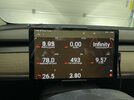Approaching this from a different angle, I have a 2023 M3 LR delivered in December of 2022. Currently 4200 miles.
I’ve never charged to 100 percent or even above 90. I regularly keep it at 50 SOC.
Any reason I should charge to 100 for a commute even though my distance never requires it ? Curious what the consensus is if I don’t leave it sitting at 100 and if there are any positives to an occasional run to 100.
For the sake of the battery there is no gain to charge to 100%.
Lithium ion batteries do
not suffer from any memory effect so they are happy with continously cycling at low SOC.
The researchers testing batteries periodically stop the test cycles and do full cycles to measure the capacity. This is done to be able to track the cyclic aging.
This is often done after each 100 or 200 or 250 cycles or so.
In general we do not see any research tests without the periodical full cycles, but we can be quite sure about that they will not add anything to the batteries life. (Not that bad either).
For the sake of the car, there might happen that the BMS looses track of the battery capacity and from that either overestimate or underestimate the battery capacity.
Its common on these forums that people are unhappy with the displayed range at 100%, or for example at 90% but converted to 100%.
To try to up the range its possible to “show” the battery capacity by having the car sleeping at low SOC and also at high SOC (called “BMS Calibration” on the forums)
This usually increases the displayed range if the BMS underestimates the capacity.
In general, using high SOC either often or periodical might help the BMS keep track of the capacity.
I havent used that technique, I use low SOC mostly but I have one longer trip back and forth each month to work and also about one/month to my mother in law. In these cases I have often charged to 100% to read the range (out of curiosity). Otherwise, about 80-90% has been needed.
I would not care very much if the displayed range got lower, I am quite sure about that the low SOC strategy is best for the battery anyway.
In your case just do as you do, if you get confused about the displayed range you can perform a BMS calib.
You do not need to be afraid for charging full if the need comes up.



